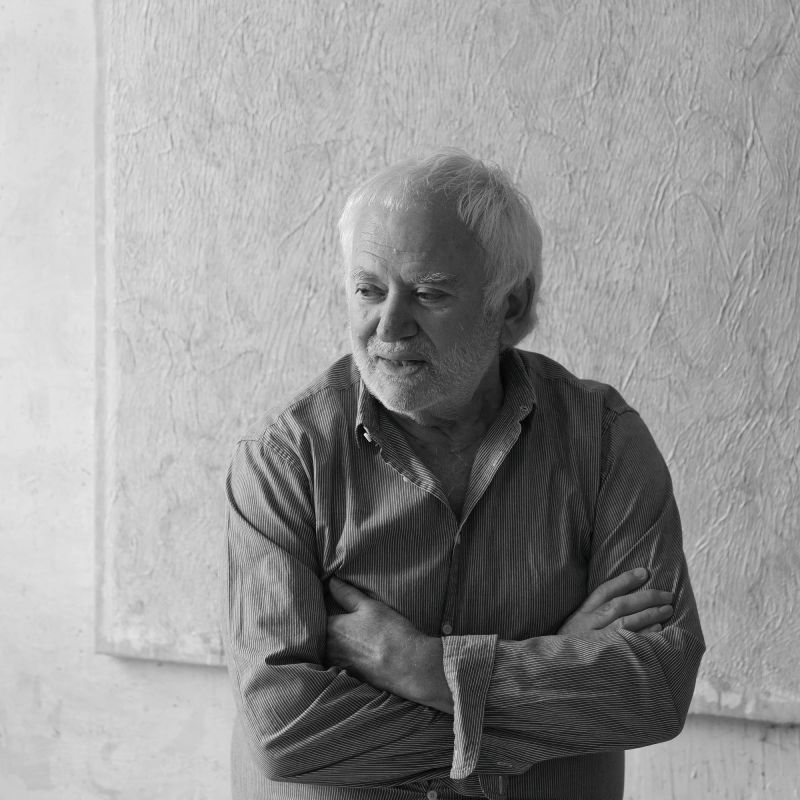TOMAS RAJLICH (1940) enjoyed an arts education in Prague at the School of Decorative Arts and Academy of Fine Arts. He trained as a sculptor and soon opted for working in the geometric vein. In 1967 he co-founded the Klub Konkretistů – the Czech equivalent of Nul or ZERO –, which acquired him national fame. A couple of years later the international art world discovered his work at the Musée Rodin in the group show Sculpture Tchécoslovaque.
In 1969 Rajlich decided to flee his homeland due to the Soviet Occupation and settled in the Netherlands. He was named professor at the Vrije Academie and found his vocation to become a painter. Represented by the galleries Art & Project, Amsterdam, and Yvon Lambert, Paris, before long his work was appreciated on an international scale. Rajlich was invited to participate in ground-breaking exhibitions like Elementaire Vormen (traveling exhibition, 1975), Fractures du Monochrome aujourd’hui en Europe (Musée d'Art Moderne de la Ville de Paris, 1978), Bilder ohne Bilder (Rheinisches Landesmuseum Bonn, 1978) and, most importantly, Fundamental Painting (1975) at the Stedelijk Museum Amsterdam.
As this exhibition pointed out, Rajlich’s canvases show an ongoing concern with the “fundamental” in painting, not unlike contemporary work by the American Minimalist painters. His early works are characterized by an industrial outlook and a modular quality – their trademark is the grid –, while Rajlich’s mature works show a more complex treatment of the key idea that painting is a self-reflective entity. His recent monochromes explore the combination of the impersonal, the gestural and the creative force of light; they are variations on the intensity, luminosity and facture of the paint, all while clearly remaining a factual painting. The artist’s sensibility emanates from the subtle modulation of the paint on the canvas; yet, the emphasis is on color and the other elements of painting as well as on the creative force of light that eternally changes the painted surface – all the while emphasizing the two-dimensional quality of the object. The focus is entirely on the painting in and of itself. The plays of light merely imbue these canvases with a life of their own, which never ceases to tickle the sensibility of the viewer. These are paintings continuously reviewing painting.
Rajlich’s first retrospective show was presented by the Palazzo Martinengo, Brescia, in 1993. His adoptive nation, the Netherlands, awarded Rajlich the prestigious Ouborg Award for his lifetime endeavors in 1994, at which occasion the Haags Gemeentemuseum showed a second retrospective exhibition; and a decade later in 2005, in honor of his 65th birthday, the museum hosted a retrospective of the artist’s works on paper. In his native Czech Republic, the Dům umění města Brna featured a retrospective in 1998, and the National Gallery in Prague showed a retrospective made out of 27 large-scale canvases a decade later. Recent solo shows include Structures in Paint at the Gemeentemuseum Den Haag (2016), a retrospective show at Museum Kampa in Prague (2017) and an exhibition of large-scale canvases at Museum Boijmans Van Beuningen, Rotterdam (2018). In 2020 Rajlich was awarded the Premio Internazionale Bice Bugatti Segantini and 2022 he was inducted in the Hall of Fame of the Czech Academy of Visual Arts for his lifetime work.
Rajlich’s works are part of numerous respected public collections worldwide, for example: Stedelijk Museum Amsterdam, Amsterdam; Museum of Modern Art, New York; MNAM/Centre Georges Pompidou, Paris; SMAK, Ghent; National Gallery of Canada, Ottawa; and the National Gallery in Prague. Likewise, he was commissioned to execute monumental canvases, as for example for the The Council of State in The Hague and the Embassy of the Netherlands in Accra, Ghana. From 1999 to 2002 Rajlich was an artist in residence at the MNAM/Centre Georges Pompidou in Paris. And after over four decades in the Netherlands, with frequent stays near Verona, Italy, in 2010 Rajlich returned to Prague, where he lives and works.
